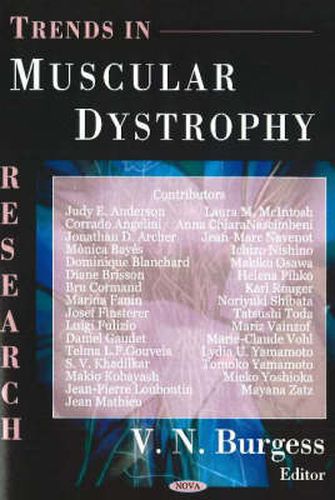Readings Newsletter
Become a Readings Member to make your shopping experience even easier.
Sign in or sign up for free!
You’re not far away from qualifying for FREE standard shipping within Australia
You’ve qualified for FREE standard shipping within Australia
The cart is loading…






The muscular dystrophies (MD) are a group of genetic diseases characterised by progressive weakness and degeneration of the skeletal muscles which control movement. There are many forms of muscular dystrophy, some noticeable at birth (congenital muscular dystrophy), others in adolescence (Becker MD), but the 3 most common types are Duchenne, facioscapulohumeral, and myotonic. These three types differ in terms of pattern of inheritance, age of onset, rate of progression, and distribution of weakness. Duchenne MD primarily affects boys and is the result of mutations in the gene that regulates dystrophin – a protein involved in maintaining the integrity of muscle fibre. Onset is between 3-5 years and progresses rapidly. Most boys become unable to walk at 12, and by 20 have to use a respirator to breathe. Facioscapulohumeral MD appears in adolescence and causes progressive weakness in facial muscles and certain muscles in the arms and legs. It progresses slowly and can vary in symptoms from mild to disabling. Myotonic MD varies in the age of onset and is characterised by myotonia (prolonged muscle spasm) in the fingers and facial muscles; a floppy-footed, high-stepping gait; cataracts; cardiac abnormalities; and endocrine disturbances. Individuals with myotonic MD have long faces and drooping eyelids; men have frontal baldness. This volume presents leading-edge research results on MD.
$9.00 standard shipping within Australia
FREE standard shipping within Australia for orders over $100.00
Express & International shipping calculated at checkout
The muscular dystrophies (MD) are a group of genetic diseases characterised by progressive weakness and degeneration of the skeletal muscles which control movement. There are many forms of muscular dystrophy, some noticeable at birth (congenital muscular dystrophy), others in adolescence (Becker MD), but the 3 most common types are Duchenne, facioscapulohumeral, and myotonic. These three types differ in terms of pattern of inheritance, age of onset, rate of progression, and distribution of weakness. Duchenne MD primarily affects boys and is the result of mutations in the gene that regulates dystrophin – a protein involved in maintaining the integrity of muscle fibre. Onset is between 3-5 years and progresses rapidly. Most boys become unable to walk at 12, and by 20 have to use a respirator to breathe. Facioscapulohumeral MD appears in adolescence and causes progressive weakness in facial muscles and certain muscles in the arms and legs. It progresses slowly and can vary in symptoms from mild to disabling. Myotonic MD varies in the age of onset and is characterised by myotonia (prolonged muscle spasm) in the fingers and facial muscles; a floppy-footed, high-stepping gait; cataracts; cardiac abnormalities; and endocrine disturbances. Individuals with myotonic MD have long faces and drooping eyelids; men have frontal baldness. This volume presents leading-edge research results on MD.